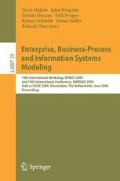Abstract
There is a wide variety of drivers for business process modelling initiatives, reaching from business evolution and process optimisation over compliance checking and process certification to process enactment. That, in turn, results in models that differ in content due to serving different purposes. In particular, processes are modelled on different abstraction levels and assume different perspectives. Vertical alignment of process models aims at handling these deviations. While the advantages of such an alignment for inter-model analysis and change propagation are out of question, a number of challenges has still to be addressed. In this paper, we discuss three main challenges for vertical alignment in detail. Against this background, the potential application of techniques from the field of process integration is critically assessed. Based thereon, we identify specific research questions that guide the design of a framework for model alignment.
Access this chapter
Tax calculation will be finalised at checkout
Purchases are for personal use only
Preview
Unable to display preview. Download preview PDF.
References
Ramackers, G.J.: Integrated Object Modelling. PhD thesis, Leiden University, Thesis Publishers, Amsterdam (1994)
Grover, V., Fiedler, K., Teng, J.: Exploring the Success of Information Technology Enabled Businessprocess Reengineering. IEEE Transactions on Engineering Management 41(3), 276–284 (1994)
Rolland, C., Prakash, N.: Bridging the Gap Between Organisational Needs and ERP Functionality. Requirements Engineering 5(3), 180–193 (2000)
Henkel, M., Zdravkovic, J., Johannesson, P.: Service-based processes: Design for business and technology. In: Aiello, M., Aoyama, M., Curbera, F., Papazoglou, M.P. (eds.) ICSOC, pp. 21–29. ACM, New York (2004)
Koehler, J., Hauser, R., Küster, J.M., Ryndina, K., Vanhatalo, J., Wahler, M.: The Role of Visual Modeling and Model Transformations in Business-driven Development. Electr. Notes Theor. Comput. Sci. 211, 5–15 (2008)
Rosemann, M.: Preparation of Process Modeling. In: Process Management: A Guide for the Design of Business Processes, pp. 41–78. Springer, Heidelberg (2003)
OMG: Business Process Modeling Notation (BPMN) 1.1(January 2008)
Bergholtz, M., Jayaweera, P., Johannesson, P., Wohed, P.: A Pattern and Dependency Based Approach to the Design of Process Models. In: Atzeni, P., Chu, W., Lu, H., Zhou, S., Ling, T.-W. (eds.) ER 2004. LNCS, vol. 3288, pp. 724–739. Springer, Heidelberg (2004)
Andersson, B., Bergholtz, M., Edirisuriya, A., Ilayperuma, T., Johannesson, P.: A Declarative Foundation of Process Models. In: Pastor, Ó., Falcão e Cunha, J. (eds.) CAiSE 2005. LNCS, vol. 3520, pp. 233–247. Springer, Heidelberg (2005)
Decker, G.: Bridging the Gap between Business Processes and existing IT Functionality. In: Proceedings of the 1st International Workshop on Design of Service-Oriented Applications (WDSOA), Amsterdam, The Netherlands, pp. 17–24 (2005)
Frank, H., Eder, J.: Towards an Automatic Integration of Statecharts. In: Akoka, J., Bouzeghoub, M., Comyn-Wattiau, I., Métais, E. (eds.) ER 1999. LNCS, vol. 1728, pp. 430–444. Springer, Heidelberg (1999)
Mendling, J., Simon, C.: Business Process Design by View Integration. In: [28], pp. 55–64
Küster, J.M., Koehler, J., Ryndina, K.: Improving Business Process Models with Reference Models in Business-Driven Development. In: [28], pp. 35–44
Dijkman, R.M.: A Classification of Differences between Similar Business Processes. In: EDOC, pp. 37–50. IEEE Computer Society, Los Alamitos (2007)
Dijkman, R.M.: Diagnosing differences between business process models. In: Dumas, M., Reichert, M., Shan, M.-C. (eds.) BPM 2008. LNCS, vol. 5240, pp. 261–277. Springer, Heidelberg (2008)
Dijkman, R.M., Quartel, D.A.C., Pires, L.F., van Sinderen, M.: A Rigorous Approach to Relate Enterprise and Computational Viewpoints. In: EDOC, pp. 187–200. IEEE Computer Society, Los Alamitos (2004)
van Dongen, B.F., Dijkman, R.M., Mendling, J.: Measuring Similarity between Business Process Models. In: Bellahsene, Z., Léonard, M. (eds.) CAiSE 2008. LNCS, vol. 5074, pp. 450–464. Springer, Heidelberg (2008)
Li, C., Reichert, M., Wombacher, A.: On Measuring Process Model Similarity based on High-level Change Operations. In: Li, Q., Spaccapietra, S., Yu, E., Olivé, A. (eds.) ER 2008. LNCS, vol. 5231, pp. 248–264. Springer, Heidelberg (2008)
Soffer, P.: Refinement equivalence in model-based reuse: Overcoming differences in abstraction level. J. Database Manag. 16(3), 21–39 (2005)
Basten, T., van der Aalst, W.M.P.: Inheritance of Behavior. Journal of Logic and Algebraic Programming (JLAP) 47(2), 47–145 (2001)
Ebert, J., Engels, G.: Observable or Invocable Behaviour - You Have to Choose. Technical Report 94-38, Department of Computer Science, Leiden University (December 1994)
Schrefl, M., Stumptner, M.: Behavior-consistent specialization of object life cycles. ACM Trans. Softw. Eng. Methodol. 11(1), 92–148 (2002)
Weidlich, M., Decker, G., Weske, M., Barros, A.: Towards Vertical Alignment of Process Models - A Collection of Mismatches. Technical report, Hasso Plattner Institute (2008), http://bpt.hpi.uni-potsdam.de/pub/Public/BptPublications/collection_of_mismatches.pdf
Hohpe, G., Woolf, B.: Enterprise Integration Patterns: Designing, Building, and Deploying Messaging Solutions. Addison-Wesley, Reading (2003)
Grossmann, G., Schrefl, M., Stumptner, M.: Classification of business process correspondences and associated integration operators. In: Wang, S., Tanaka, K., Zhou, S., Ling, T.-W., Guan, J., Yang, D.-q., Grandi, F., Mangina, E.E., Song, I.-Y., Mayr, H.C. (eds.) ER Workshops 2004. LNCS, vol. 3289, pp. 653–666. Springer, Heidelberg (2004)
Henkel, M., Zdravkovic, J.: Supporting development and evolution of service-based processes. In: ICEBE, pp. 647–656. IEEE CS, Los Alamitos (2005)
Davis, F.D.: Perceived usefulness, perceived ease of use, and user acceptance of information technology. MIS Quarterly, 319–339 (September 1989)
Eder, J., Dustdar, S. (eds.): BPM Workshops 2006. LNCS, vol. 4103. Springer, Heidelberg (2006)
Author information
Authors and Affiliations
Editor information
Editors and Affiliations
Rights and permissions
Copyright information
© 2009 Springer-Verlag Berlin Heidelberg
About this paper
Cite this paper
Weidlich, M., Barros, A., Mendling, J., Weske, M. (2009). Vertical Alignment of Process Models – How Can We Get There?. In: Halpin, T., et al. Enterprise, Business-Process and Information Systems Modeling. BPMDS EMMSAD 2009 2009. Lecture Notes in Business Information Processing, vol 29. Springer, Berlin, Heidelberg. https://doi.org/10.1007/978-3-642-01862-6_7
Download citation
DOI: https://doi.org/10.1007/978-3-642-01862-6_7
Publisher Name: Springer, Berlin, Heidelberg
Print ISBN: 978-3-642-01861-9
Online ISBN: 978-3-642-01862-6
eBook Packages: Computer ScienceComputer Science (R0)

